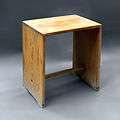Hans Gugelot
Hans Gugelot (1920-1965) was an Indonesian-born, German engineer and industrial designer known for his modernist consumer products.[1][2]
Hans Gugelot | |
|---|---|
| Born | Johan Gugelot April 1, 1920 |
| Died | September 10, 1965 Ulm, Germany |
| Education | ETH Zurich |
| Parent(s) | Pieter Cornelis Gugelot |

Life and work
Johan Gugelot was born on April 1, 1920 in Makassar, Dutch East Indies to Dutch parents.[3]
He completed his early education in Laren and Hilversum, North Holland.
In 1934, the Gugelot family moved to Davos, Switzerland for Hans's father's job as a physician.
Between 1940 and 1942 Gugelot studied architecture in Lausanne , and graduated as an architect from Eidgenössische Technische Hochschule (ETH), Zurich in 1946.
Until 1948 worked as an architect for a number of architects.[4]In 1947, he married.
In 1948, Gugelot was hired by Max Bill, for whom he created his first furniture designs.[4][5]
In 1950 Gugelot founded his own office and began designing "M 125," a shelving and storage for which he later became known. Another influential work of Gugelot's in this period was the Ulm Stool, which he designed in collaboration with Bill.[3]
In 1954, Gugelot met Erwin Braun, then-head of German consumer product company, Braun. Throughout the remained of the decade, Gugelot created a number of designs for the company, including the Braun SK 4, which he designed with Dieter Rams.[4][3]
Gallery
- Notable works
 Ulm Stool (1954)
Ulm Stool (1954) Braun SM 2 shaver (1963)
Braun SM 2 shaver (1963) SK 4/10 (1956) Radio-Phonograph for Braun
SK 4/10 (1956) Radio-Phonograph for Braun M125 storage system (1956)
M125 storage system (1956)
References
- "Hans Gugelot - Lebenslauf". www.hansgugelot.com. Retrieved 2019-04-07.
- "Hans Gugelot - Oxford Reference". www.oxfordreference.com. doi:10.1093/oi/authority.20110803095911380. Retrieved 2019-04-07.
- "KulturPortal Frankfurt: Persons". www.kultur-frankfurt.de. Retrieved 2019-04-16.
- WICHMANN (2013-12-14). System-Design Bahnbrecher: Hans Gugelot 1920–65 (in German). Springer-Verlag. p. 10. ISBN 9783034860314.
- "Hans Gugelot – Biografien – eMuseum Museum für Gestaltung Zürich Archiv Zürcher Hochschule der Künste ZHdK". www.emuseum.ch (in German). Retrieved 2019-04-16.